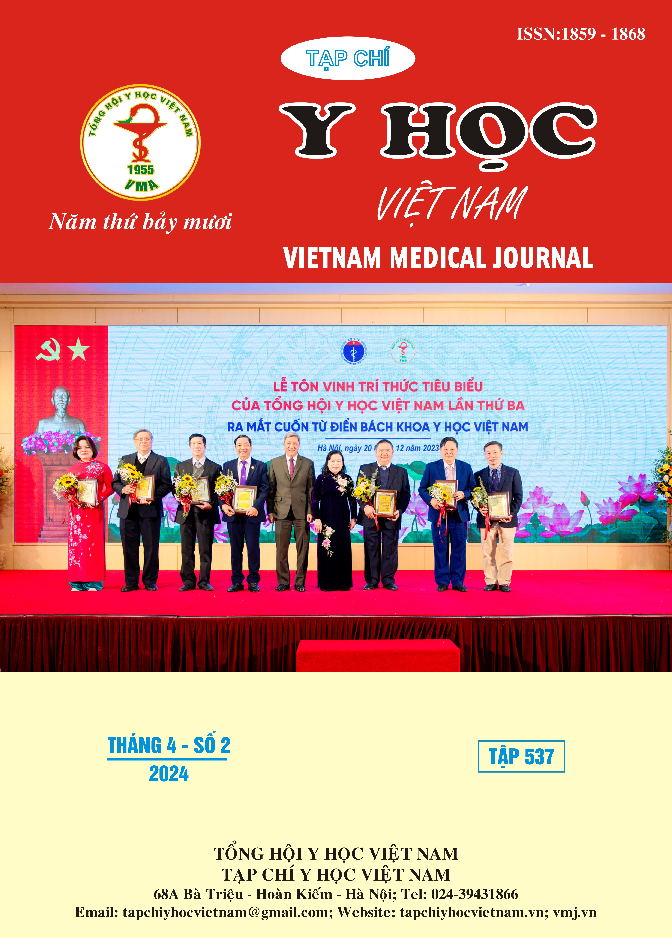CHARACTERISTICS OF CLINICAL, SUBCLINICAL, MEDICAL IMAGE AND RESULTS OF TREATMENT OF PATIENTS WITH SEVERE TRAUMA BRAIN INJURY AT THE SURGICAL INTENSIVE CARE UNIT AT NGHE AN GENERAL HOSPITAL
Main Article Content
Abstract
Objective: to describe the clinical, laboratory, imaging characteristics and treatment results of patients with severe traumatic brain injury at the surgical intensive care unit of Nghe An General Friendship Hospital. Subjects and methods: cross-sectional descriptive study on 51 patients with severe traumatic brain injury who undergone brain decompression surgery, and were under post-operative treatment at the surgical intensive care unit, Nghe An General Friendship Hospital from October 2022 to June 2023. Results: The largest age group was 40-59 years old (41.2%). Male patients made up the majority with 86.3%. Traffic accidents were the most common cause with 78.4%. Glasgow coma score at admission was 6 - 8 points, accounting for 94.1%. 37.3% of cases had dilated pupils and loss of light reflex on one side, and 3.9% of cases had dilated pupils and loss of light reflex on both sides. 19.6% of patients had images of arachnoid bleeding. Subdural hematoma was the most common lesion with a rate of 45.1%. 19.6% of patients had combined lesions. The majority had midline displacement of 6-10 mm, accounting for 66.7%. 45.1% of patients had basal cisternae with compression and opacification of varying degrees. The proportion of patients with a Rotterdam score of 5 accounting for 7.8%. The death rate after 1 month was 11.8%, the proportion of patients with good outcome after treatment was 56.9%. The average number of treatment duration was 20.47 ± 11.83 days, the average number of postoperative duration was 19.70 ± 11.81 days. Conclusion: Clinical features and computed tomography images in patients with severe traumatic brain injury are diverse. With the improvement of surgical techniques and post-operative management, the mortality rate and serious sequelae of patients with traumatic brain injury have decreased significantly.
Article Details
Keywords
severe traumatic brain injury, release of brain compression, Nghe An General Friendship Hospital
References
2. Huang YH, Deng YH, Lee TC, Chen WF. Rotterdam computed tomography score as a prognosticator in head-injured patients undergoing decompressive craniectomy. Neurosurgery. 2012; 71(1): 80-85. doi:10.1227/ NEU.0b013e3182517aa1
3. Nguyễn Thế Hào, Phạm Quỳnh Trang. (2013) Nghiên cứu biến chứng sớm sau phẫu thuật giảm áp trong chấn thương sọ não nặng. Y Học Thực Hành., 891:265 - 267.
4. Chesnut RM. Intracranial pressure monitoring: headstone or a new head start. The BEST TRIP trial in perspective. Intensive Care Med. 2013;3 9(4): 771-774. doi:10.1007/s00134-013-2852-9
5. Wu X, Hu J, Zhuo L, et al. Epidemiology of traumatic brain injury in eastern China, 2004: a prospective large case study. J Trauma. 2008; 64(5): 1313-1319. doi:10.1097/TA. 0b013e318165c803
6. Carney N, Totten AM, O’Reilly C, et al. Guidelines for the Management of Severe Traumatic Brain Injury, Fourth Edition. Neurosurgery. 2017;80(1):6-15. doi:10.1227/NEU. 0000000000001432
7. Bùi Ngọc Tiến. (2012) Phẫu thuật giải phóng chèn ép não trên bệnh nhân chấn thương sọ não nặng. Y Học Thực Hành., 16:212 - 214.
8. Nguyễn Công Tô, Nguyễn Đình Hưng. (2010) Các yếu tố tiên lượng của chấn thương sọ não vừa và nặng. Y Học Thực Hành., 734:247 - 252.


